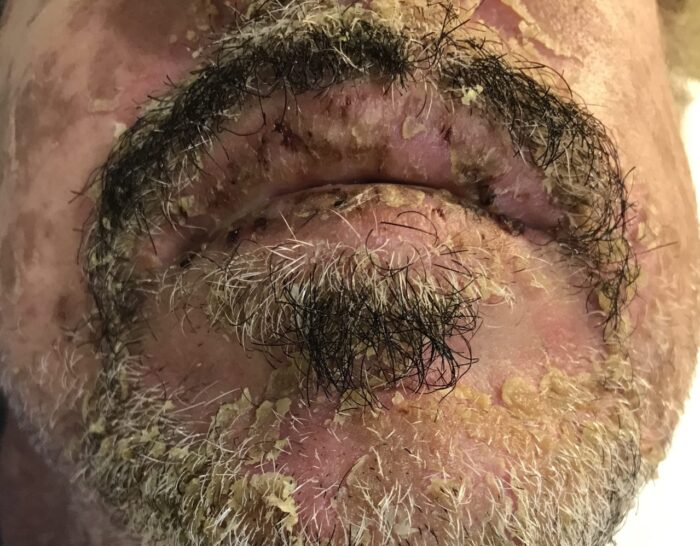Top Class Actions’s website and social media posts use affiliate links. If you make a purchase using such links, we may receive a commission, but it will not result in any additional charges to you. Please review our Affiliate Link Disclosure for more information.

(Photo Credit: TisforThan/Shutterstock)
Have you or someone you love been diagnosed with Stevens Johnson Syndrome? If so, you are probably searching for answers about what caused this rare condition.
What is Stevens Johnson Syndrome?
Stevens Johnson Syndrome (SJS) is a rare and potentially fatal allergic reaction to medication. Patients with Stevens Johnson Syndrome suffer skin lesions and blisters over their body, which result in skin sloughing off.
Stevens Johnson Syndrome and its more severe form, Toxic Epidermal Necrolysis, can start with non-specific symptoms such as cough, aching, headaches and fever. This may be followed by a red rash across the face and the trunk of the body, which can continue to spread to other parts of the body. The rash can form into blisters. SJS can occur both on skin and on mucus membranes, affecting body parts like the eyes, mouth and genital area. This disease can leave the skin looking as though it has been burned, and areas where skin has flayed away can seep copiously and quickly become infected.
In the case of Toxic Epidermal Necrolysis, the skin can become so damaged that layers of the skin can come away with ease. In some cases, the skin peels away in sheets. The hair and nails can also come away. During this process, sufferers can often become cold and feverish.
Changed “With Toxic Epidermal Necrolysis, the most common cause of death is infection, which can enter through the exposed areas.” to “The most common cause of death related to Toxic Epidermal Necrolysis infection, which can be caused when bacteria enter through the exposed areas. The damaged skin does not heal easily, allowing infections to worsen and spread.”
Those suffering from SJS or TEN are treated in a hospital, typically in a burn unit. If the condition was caused by a drug the patient was taking, then the drug in question is stopped immediately. In some cases, this can stop the progression of the condition and can allow the patient to heal. Surviving patients are treated intravenously to replace any lost fluids, and the skin is left to re-grow on its own.
Survivors may experience serious complications during and after their recovery. This can include:
- loss of body fluids
- shock
- inflammation of the lungs, kidneys, liver and heart
- permanent skin damage and scarring
The chances of survival can vary depending on the level of damage and the degree of infection suffered by the patient.
How do you get Stevens Johnson Syndrome?
In most cases, Stevens Johnson Syndrome is caused by an allergic reaction to a drug. One drug that has come under fire lately for possible connection to Stevens Johnson Syndrome is the prescription antibiotic Zithromax.
Zithromax (azithromycin) is an antibiotic sold by Pfizer and used for mild to moderate infections. Also known as “Zmax” and “Z-Pak,” the drug became popular in the 1990s because it treated infections in only five days. In 2012, the U.S. Food and Drug Administration (FDA) issued a warning that Zithromax can lead to Steven Johnson Syndrome.
There are countless other medications that may lead to SJS. Zylopram, Lamictal and even Advil have all been linked to the condition. According to the Mayo Clinic, the following drugs may also cause Steven Johnson Syndrome:
- Anti-gout medications (allopurinol, etc.)
- Anti-seizure medications
- Anti-psychotic medications
- Antibacterial sulfonamides
- Antibiotics
- Nevirapine (Viramune, Viramune XR)
- Pain relievers (Tylenol, Motrin, Aleve and more)
SJS lawsuits
Stevens Johnson Syndrome is rare condition and is seldom reported. While drug labels typically do warn of severe allergic reactions, people who have suffered from Stevens Johnson Syndrome after taking medications have filed lawsuits against the drug manufacturer, alleging that warnings of Stevens Johnson Syndrome causes were not adequately indicated on the drug label.” to “alleging that the risk of developing Stevens Johnson Syndrome was not adequately indicated on the drug label.
Do YOU have a legal claim? Fill out the form on this page now for a free, immediate, and confidential case evaluation. The Stevens Johnson Syndrome attorneys who work with Top Class Actions will contact you if you qualify to let you know if an individual lawsuit or class action lawsuit is best for you. [In general, SJS lawsuits are filed individually by each plaintiff and are not class actions.] Hurry — statutes of limitations may apply.
ATTORNEY ADVERTISING
Top Class Actions is a Proud Member of the American Bar Association
LEGAL INFORMATION IS NOT LEGAL ADVICE
Top Class Actions Legal Statement
©2008 – 2024 Top Class Actions® LLC
Various Trademarks held by their respective owners
This website is not intended for viewing or usage by European Union citizens.
Get Help – It’s Free
Help for Victims of Stevens Johnson Syndrome
If you or a loved one were diagnosed with Stevens Johnson Syndrome (SJS) or toxic epidermal necrolysis (TEN) after taking a prescribed or over-the-counter medication, you may be eligible to take legal action against the drug’s manufacturer. Filing an SJS lawsuit or class action lawsuit may help you obtain compensation for medical bills, pain and suffering, and other damages. Obtain a free and confidential review of your case by filling out the form below.
An attorney will contact you if you qualify to discuss the details of your potential case at no charge to you.
Oops! We could not locate your form.












